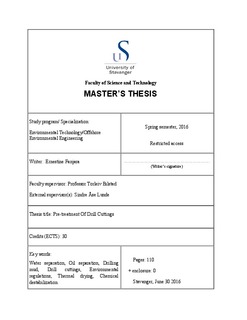| dc.contributor.advisor | Bilstad, Torleiv | |
| dc.contributor.author | Fanjara, Ernestine | |
| dc.date.accessioned | 2016-09-26T13:21:12Z | |
| dc.date.available | 2016-09-26T13:21:12Z | |
| dc.date.issued | 2016-06 | |
| dc.identifier.uri | http://hdl.handle.net/11250/2410630 | |
| dc.description | Master's thesis in Environmental Technology/ Offshore Environmental Engineering | nb_NO |
| dc.description.abstract | The need for more environmental and economical solutions to treat drilling waste offshore led Norwegian-Group AS to develop a novel technology. This technology is based on microwave processing of drilling waste. The efficiency and the capacity of microwave treatment is, however, limited by susceptor availability. To overcome this limitation, environmentally friendly chemicals, which have lower enthalpy of vaporization than water, are used. Proper pre-treatment of drill cuttings, which is the main subject of this thesis, is also required for this technology.
The aim of this thesis is to elaborate potential methods for proper pre-treatment of drill cuttings. To achieve this objective, the drilling wastes are first reviewed to understand their composition, the bonding system between oil, water and cuttings, the magnitude of the produced waste as well as the disposal options available for waste handling. The choice of the potential method relies on these parameters since they influence the efficiency of a treatment method. The existing regulations as well as the technologies currently available for offshore treatment of drill cuttings are also briefly discussed. Some potential drying methods for cuttings are presented, and techniques based on convective thermal drying are further evaluated. A pre-treatment method
based on chemical and centrifugal separation was also tested in the laboratory to evaluate its feasibility. The experiment was carried out in two phases. The first phase was used to verify the effect of MudSplit chemicals on drill cuttings and the optimal conditions of their use. The second phase was dedicated to further testing the effect of MudSplit chemical by combining it with solvent extraction.
The evaluation of the convective drying methods indicated that high separation efficiency, very low energy consumption and high treatment capacity can be achieved with these methods.
The laboratory testing demonstrated that MudSplit 02 chemical followed by centrifugal separation is efficient in dewatering drill cuttings. However, it was ineffective in terms of oil separation and did not enhance the oil extraction when combined with solvents. | nb_NO |
| dc.language.iso | eng | nb_NO |
| dc.publisher | University of Stavanger, Norway | nb_NO |
| dc.relation.ispartofseries | Masteroppgave/UIS-TN-IMN/2016; | |
| dc.rights | Navngivelse 3.0 Norge | * |
| dc.rights.uri | http://creativecommons.org/licenses/by/3.0/no/ | * |
| dc.subject | teknisk miljøvern | nb_NO |
| dc.subject | offshore teknologi | nb_NO |
| dc.subject | vann | nb_NO |
| dc.subject | water separation | nb_NO |
| dc.subject | oil separation | nb_NO |
| dc.subject | drill mud | nb_NO |
| dc.subject | drill cuttings | nb_NO |
| dc.subject | environmental regulations | nb_NO |
| dc.subject | thermal drying | nb_NO |
| dc.subject | chemical destabilization | nb_NO |
| dc.title | Pre-Treatment Of Drill Cuttings | nb_NO |
| dc.type | Master thesis | nb_NO |
| dc.subject.nsi | VDP::Technology: 500::Environmental engineering: 610 | nb_NO |

